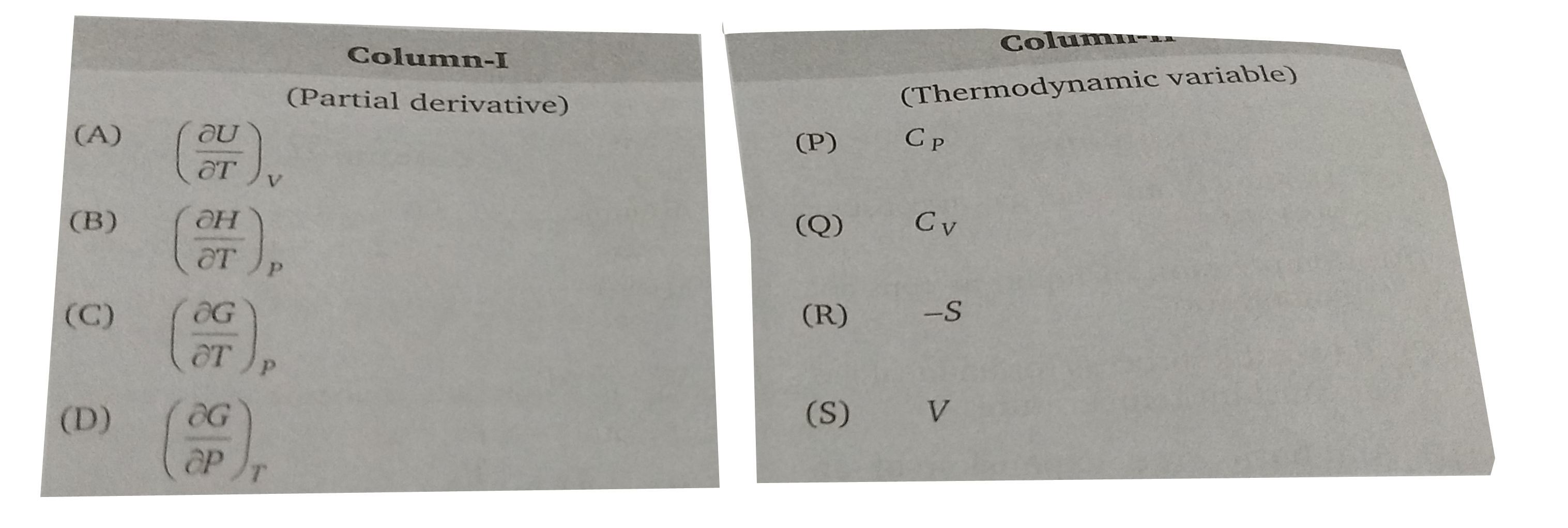Determine which of the following reactions taking place at constant pressure represents system that do work on the surrounding environment
Ag+(aq)+Cl−(aq)→AgCl(s) (II)NH4Cl(s)→NH3(g)+HCl(g) (III)2NH3(g)→N2(g)+3H2(g) Solution in Punjabi
I
III
II and III
I and II
The correct Answer is:C
W=−ΔngRT=−ve
II. Δng=2, III. Δng=2
Topper's Solved these Questions
- BOOK - NARENDRA AWASTHICHAPTER - THERMODYNAMICSEXERCISE - Level 3 - One Or More Answers Are Correct1videos
THERMODYNAMICS
- BOOK - NARENDRA AWASTHICHAPTER - THERMODYNAMICSEXERCISE - Level 3 - Match The Column2videos
THERMODYNAMICS
- BOOK - NARENDRA AWASTHICHAPTER - THERMODYNAMICSEXERCISE - Level 2 (Q.1 To Q.30)1videos
THERMODYNAMICS
- BOOK - NARENDRA AWASTHICHAPTER - STOICHIOMETRYEXERCISE - Level 3 - Subjective Problems20videos
STOICHIOMETRY
Similar Questions
Assume ideal gas behaviour for all the gases considered and neglect vibrational degrees of freedom. Separate equimolar sample. Separate equimolar samples of Ne, O2 , CO2 and SO2 were subjected to a two process as mentioned. Initially all are at same state of temperature and pressue.
Step I → All undergo reversible adiabatic expansion to attain same final volume, which is double the original volume thereby causing the decreases in their temperature.
Step → After step I all are given appropriate amount of heat isochorically to restore the original temperature.
Mark the correct option(s) :01:31View SolutionMatch the following columns
 03:20View Solution
03:20View SolutionWrite structure of 2,2-dimethylheptane.
01:20View SolutionWhat volume of a liquid (in L) will contain 10 mole ? If molar mass of liquid is 280 and its density is 1.4 g/mL.
02:37View SolutionPredict which of the following reaction (s) has a positive entropy change?
I . Ag+(aq)+Cl−(aq)→AgCl(s)
II . NH4Cl(s)→NH3(g)+HCl(g)
III . 2NH3(g)→N2+3H2(g)04:04View SolutionGvien the following value for the standard molar Gibbs free energy changes? G^(@) , at 25^(@)C Ag^(+) (aq) + 2NH_(3) (l) hArr Ag (NH_(3))_(2)^(+) (aq) ? G^(2) = -41.0KJ (mol Ag^(+))^(-1) Ag^(+) (aq) + Cl^(-)(aq) hArr AgCl (s) ? G^(@) = - 55.6 kJ (mol Ag^(+))^(-1) Calculate the value for the thermodynamic equilibrium constant. K, at 25^(@)C for the reactions: AgCl (s) + 2NH_(3) (l) hArr Ag (NH_(3))_(2)^(+) (aq) + Cl (aq)
01:08View SolutionDetermine which of the following reaction at constant pressure represent systems that do work on the surrounding environment
(I) CaO(s)+CO2(g)→CaCO3(s)
(II) NH4Cl(s)→NH3(g)+HCl(g)
(III) 2NH3(g)→N2(g)+3H2(g)View SolutionDetermine which of the following reactions taking place at constant pressure represents system that do work on the surrounding environment
Ag+(aq)+Cl−(aq)→AgCl(s) (II)NH4Cl(s)→NH3(g)+HCl(g) (III)2NH3(g)→N2(g)+3H2(g)View SolutionIn the reaction:
2Al(s)+6HCl(aq.)→2Al3+(aq.)+6Cl−(aq.)+3H2(g)05:50View SolutionPredict which of the following reaction(s) has a positive entropy change?
I Ag+(aq)+CI−(aq)→AgCI(s)
I NH4CI(s)→NH3(g)+HCI(g)
III 2NH3(g)→N2(g)+3H2(g)
IV 2NH3→N2(g)+3H2(g)02:24View SolutionFind the heat change in the reaction : NH3(g)+HCl(g)→NH4Cl(s) from the following data
NH3(g)+aq→NH3(aq),ΔH=−8.4K. Cal.HCl(g)+aq→HCl(aq),ΔH=−17.3K. Cal.NH3(aq)+HCl(aq)→NH4Cl(aq),ΔH=−12.5K. Cals.NH4Cl(s)+aq→NH4Cl(aq),ΔH=+3.9K.Cal.02:24View SolutionIn the reaction : 2Al(s)+6HCl(aq)→2Al3+(aq)+6Cl−(aq)+3H2(g)
03:37View SolutionFind the heat change in the reaction:
NH3(g)+HCI(g)→NH4CI(s)
from the following data
NH3(g)+aq→NH3(aq)△H=−8.4KCal
HCl(g)+aq→HCl(aq)△H=−17.3KCal
NH3(aq)+HCl(aq)→NH4Cl(aq)△H=−12.5KCal
NH4Cl(s)+aq→NH4Cl(aq)△H=+3.9Kcal02:00View SolutionDetermine which of the following reactions at constant pressure represent systems that do work on the surrounding environment I. Ag^(+) (aq) + Cl^(-) (aq) rarr AgCl(s) II. NH_(4)Cl(s) rarr NH_(3) (g) + HCl (g) III. 2NH_(3)(g) rarr N_(2)(g) + 3H_(2)(g)
05:44View SolutionDetermine which of the following reactions at constant pressure represent systems that do work on the surrounding environment
I. Ag+(aq)+Cl−(aq)→AgCl(s) II. NH4Cl(s)→NH3(g)+HCl(g)
III. 2NH3(g)→N2(g)+3H2(g)05:26View SolutionDetermine which of the following reactions taking place at constant pressure represents system that do work on the surrounding environment
(I)Ag+(aq)+Cl−(aq)→AgCl(s)(II)NH4Cl(s)→NH3(g)+HCl(g)<br>(III)2NH3(g)→N2(g)+3H2(g)03:52View Solution

